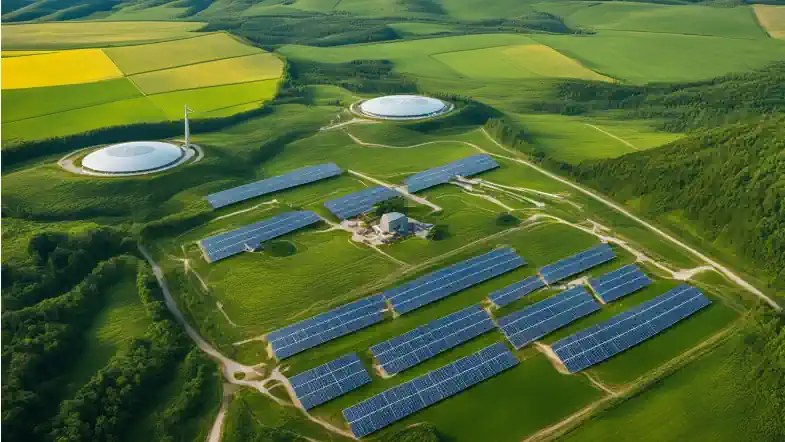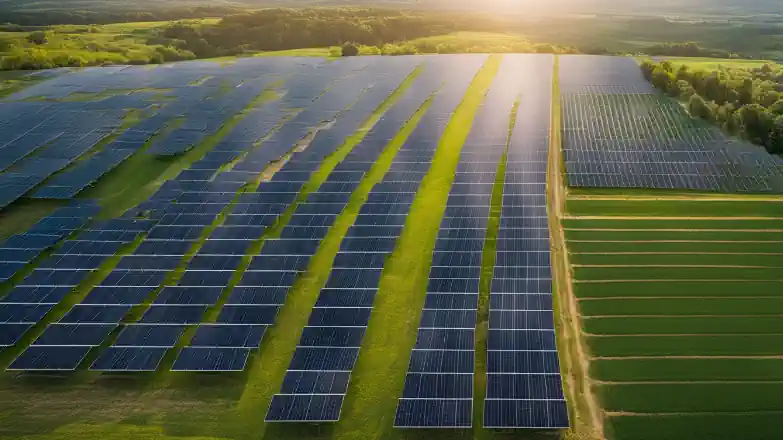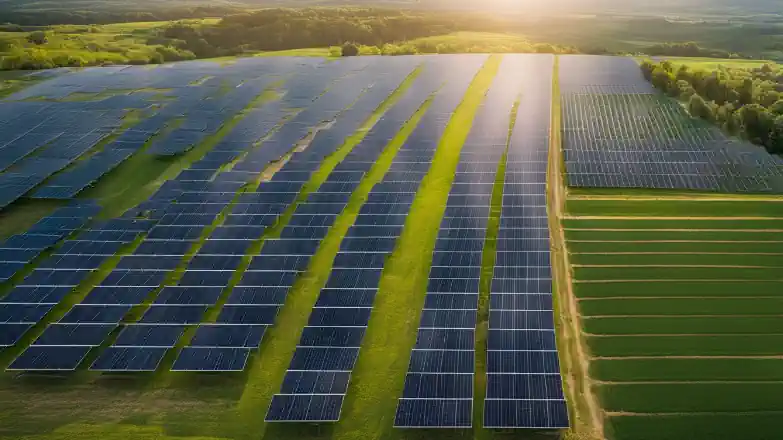Achieving Net Zero: A Roadmap to Rebalancing Atmospheric Carbon and Putting the Brakes on Climate Change
Do you find your brow furrowed in concern about the intensifying climate crisis, pondering what role you can play to assist? You're not alone. I found myself grappling with similar feelings of anxiety while harboring a resolute determination to contribute positively.
Inspired by this commitment, I embarked on a mission to comprehend how we could collectively move towards net zero – achieving equilibrium where the greenhouse gases we emit are balanced by their removal from our atmosphere.
This blog post lays out accessible steps for realizing net zero and sheds light on the intriguing rewards that lie at the end of this journey – why don't we plunge in together, navigating towards sustainability hand-in-hand?
Key Takeaways
- Net Zero refers to balancing the amount of greenhouse gas emissions produced with an equal amount of emissions removed from the atmosphere, resulting in no additional net emissions.
- To achieve Net Zero, we must reduce energy consumption, transition to renewable energy sources, implement energy-efficient technologies, and offset any remaining emissions.
- Achieving Net Zero brings benefits such as a healthier environment, cost savings, enhanced energy security, and an improved reputation.
Understanding Net Zero

Net Zero is the ultimate goal of completely balancing the amount of greenhouse gas emissions produced with an equal amount of emissions removed from the atmosphere, resulting in no additional net emissions.
Definition and goals
Net zero is the quest to achieve a balance between the amount of greenhouse gas emissions produced and the amount removed from the atmosphere. We often set this as our goal to lower these emissions as close to zero as possible.
To achieve this, we can not only reduce output but actively extract carbon dioxide already present in our atmosphere. By doing so, we counterbalance all human activity-related emissions, significantly curbing climate change's impact on our planet.
This approach ensures that the earth remains conducive for future generations while promoting socio-ecological considerations and equitable transitions towards broader sustainable development objectives.

Importance of achieving Net Zero
Achieving Net Zero plays a critical role in our fight against climate change. This goal urges us to cut greenhouse gas emissions down to the bare minimum, significantly affecting all sectors of the economy.
Our path to net zero implies balancing carbon emissions with equal amounts of removal from the atmosphere. We can achieve this through energy-efficient technology and transitioning to renewable resources while reducing our overall energy consumption.
Involving business supply chains in creating custom climate action plans also aids in decreasing emissions, which is an integral part of any achievable annual net zero targets. It's essential not only for environmental benefits but also because it offers cost savings, improved energy security, and enhances reputation and public perception.
Steps to Achieve Net Zero

To achieve Net Zero, we must firstly reduce energy consumption, transition to renewable energy sources, implement energy-efficient technologies, and offset any remaining emissions.
Reduce energy consumption

Slashing energy consumption is a key step forward in our journey to net zero. It's about more than just turning off the lights when you leave a room or lowering your thermostat, it involves making conscious, sustainable choices.
Let’s think about the transportation sector for instance; swapping out new internal combustion engine vehicles for electric ones can help reduce emissions drastically as per fact number 3 provided above.
In fact, significant changes in energy consumption will be needed to speed up this transition away from fossil fuels according to fact number 5 mentioned earlier. Remember that every little step towards reduced energy use contributes immensely to achieving our target of net zero by 2050!
Transition to renewable energy sources
Transitioning to renewable energy sources is a vital move for reducing greenhouse gas emissions and fighting climate change. It's no longer an option but a necessity to replace gas, oil-fired power with sustainable alternatives like wind, solar or hydropower.
A significant shift from fossil fuels acts as an essential pillar in our quest to achieve net zero carbon emissions by 2050. As part of your business path towards net-zero, integrating these clean energy alternatives can significantly decrease emissions and contribute to the global reduction of harmful air pollutants.
Implement energy-efficient technologies
Using energy-efficient technologies is a vital step in reaching our net zero goals. We live in a world where advanced technology has become an everyday staple, so why not use it to reduce our carbon footprint? Many of the technologies we need are already available and cost-effective.
They can effectively double global energy efficiency as suggested by IEA Efficient World Scenario.
Take LED lighting, for instance; it uses 75% less energy than traditional incandescent lights. Another example includes high-efficiency HVAC systems that consume significantly less power while maintaining comfort levels.
There's also the option of smart grids; these utilize real-time data to improve the reliability, sustainability, and efficiency of electricity distribution. At its core, implementing such solutions means transforming our businesses into smarter platforms that operate more sustainably without compromising on productivity or performance.
These efforts align seamlessly with any custom climate action plans aimed at decreasing emissions, thereby paving your business path to achieving annual net-zero targets. Through strategic supply chain management strategies involving your business's suppliers and customers alike, it becomes possible for industries across sectors to be part of this greener change.

Offset remaining emissions
Companies must take action to offset any emissions they cannot eliminate. Offsetting is a critical step in the journey towards net zero, serving as an acknowledgment that not all carbon footprints can be eradicated entirely.
Carbon offsets serve this role, coming into play once primary strategies of reduction have been implemented. Companies like EY are leading by example, currently operating on a carbon-negative basis where they remove more CO2 from the atmosphere than what they emit.
This strategy presents an efficient plan for many businesses aiming to neutralise their environmental impact and reach their net-zero goals by 2030 by balancing out unavoidable emissions through investments in environmental projects or innovations designed to absorb carbon dioxide.

Challenges and Solutions
Financial considerations can pose challenges to achieving net zero, as transitioning to renewable energy sources and implementing energy-efficient technologies can require significant investment.
However, there are solutions available, such as government grants and incentives, corporate partnerships, and innovative financing models that can help overcome these obstacles. Read more about how you can navigate the financial challenges on the path to achieving net zero.

Financial Considerations
Investing in a transition to net zero involves substantial financial outlay initially but reaps significant long-term returns. The cost of implementing my firm’s net-zero strategy looms large, particularly when considering the need to measure the impact of actions taken and account for supply chain emissions.
Notably, these expenditures extend beyond simple equipment upgrades or system overhauls. I am grappling with potential erosion of tax revenues from fossil fuel-related activity which could significantly affect public spending power within my business.
Banks have become an ally through this process by addressing financed emissions and supporting our decarbonisation efforts. A successful transition demands a whole systems approach that might pose complex challenges but also assures holistic benefits along the journey towards achieving annual net zero targets.

Infrastructure and technology limitations
Net zero emissions require significant infrastructure and technological advancements. The current state of our infrastructure poses challenges in achieving this ambitious goal. Aging buildings, outdated transportation systems, and inefficient energy grids all contribute to the limitations we face.
Additionally, technology gaps hinder progress towards net zero by limiting the availability of renewable energy sources and energy-efficient solutions. To overcome these obstacles, we must invest in upgrading our infrastructure and embracing innovative technologies that support sustainable practices.
By doing so, we can pave the way for a greener future while creating jobs and driving economic growth. Together, we can tackle these limitations head-on and make meaningful progress towards achieving net zero emissions.

Policy and regulatory support
Policy and regulatory support is crucial for addressing the challenges and finding solutions related to achieving net zero emissions. Effective policies play a significant role in driving the adoption of sustainable practices by businesses, industries, and individuals.
They help create a supportive environment that encourages investment in renewable energy sources, promotes energy-efficient technologies, and implements measures to reduce greenhouse gas emissions.
Regulatory frameworks ensure compliance with emission standards and provide accountability mechanisms. By implementing strong policies and regulations, governments can facilitate the transition towards a low-carbon economy while promoting innovation and collaboration among various stakeholders.

Benefits of Achieving Net Zero
Achieving Net Zero brings numerous benefits, including a healthier environment, cost savings, enhanced energy security, and an improved reputation and public perception.
Environmental benefits
Achieving net zero emissions brings significant environmental benefits in the fight against climate change. By reducing greenhouse gas emissions and transitioning to renewable energy sources, we can help slow down global warming and minimize the impact on our planet.
Getting to net zero requires taking action across all sectors of the economy, from implementing energy-efficient technologies to offsetting remaining emissions. The pathway to achieving net-zero emissions by 2050 may be narrow, but the benefits are immense.
Together, we can create a more sustainable future for generations to come.

Cost savings
One of the key benefits of achieving net zero is the potential for significant cost savings. By reducing energy consumption, transitioning to renewable energy sources, and implementing energy-efficient technologies, businesses and governments can lower their operational expenses.
Additionally, offsetting remaining emissions through methods like carbon credits or investments in sustainable projects can help further reduce costs. Studies have shown that investing in technologies and strategies to reach net zero can result in long-term financial gains for both organizations and economies as a whole.
For example, a report by the Office for Budget Responsibility estimated that reaching net zero in the UK by 2050 could lead to significant cost reductions over time. This makes pursuing net zero not only an environmental imperative but also a smart financial decision.

Improved energy security
Achieving net zero has a significant impact on energy security. By transitioning to renewable energy sources and reducing reliance on fossil fuels, countries can enhance their energy independence and reduce the risk of price fluctuations or supply disruptions.
This means greater stability in the availability of clean and affordable energy for all sectors, leading to a more resilient and secure energy future. In the UK, for example, the Powering Up Britain plan aims to establish policies and fund measures that support net zero growth while ensuring stable and affordable energy for the country.
The focus on improved energy security is essential not only for addressing climate change but also for strengthening national infrastructure and safeguarding against potential risks associated with traditional fuel sources.
Enhanced reputation and public perception
Achieving net zero can significantly enhance a business's reputation and public perception. When a company commits to and successfully achieves net zero, it demonstrates its commitment to sustainability and environmental responsibility.
This can attract positive attention from stakeholders, including customers, investors, and the general public. By actively reducing their carbon footprint and working towards net zero emissions, businesses can build trust with consumers who are increasingly prioritizing environmentally conscious choices.
Moreover, companies that lead in the transition to net zero are seen as forward-thinking and progressive in addressing climate change concerns, which can give them a competitive edge in the market.
In addition to improved reputation, businesses that achieve net zero can benefit financially. They reduce costs by implementing energy-efficient technologies and transitioning to renewable energy sources.
These cost savings not only contribute to their bottom line but also make them more resilient in the face of fluctuating energy prices. Furthermore, committing to net zero goals can attract investment opportunities as sustainability-focused investors seek out companies aligned with their values.

Conclusion of this article on How to Achieve Net Zero
To reach net zero, we must take action now. This means reducing energy consumption, transitioning to renewable sources, implementing energy-efficient technologies, and offsetting remaining emissions.
Despite the challenges ahead, achieving net zero is crucial for a sustainable future. Let's make a commitment to understanding what net zero means and working together towards this global goal.
Our efforts today will have a lasting impact on our environment and future generations.
FAQs
1. What is a Net Zero Plan?
A Net Zero Plan is a strategy developed by businesses to decrease emissions and achieve net-zero greenhouse gas impact.
2. How can my business plan its path to net-zero?
Your business can create custom climate action plans focusing on reducing greenhouse gas emissions and involving the supply chain in the process.
3. What role does the supply chain play in achieving net-zero?
The business supply chain plays an important role as every part of your product's journey should aim for lower emissions, helping you get closer to net zero.
4. Can we customize our own climate action plans?
Absolutely! Businesses are encouraged to build custom climate action plans that specifically target their unique emission sources, getting them one step closer to achieving the net-zero goal.
Depackaging Equipment – What It Is and Why Businesses Buy It
The use of food waste depackaging equipment, so that the organic matter can be used to make biogas renewable energy, is becoming more popular for reducuing the huge climate impact of all the food the world wastes every day. But which type is right for your facility and who are the suppliers? Food depackaging systems […]
What is Biogas?
The answer to the question, what is biogas? This environmentally friendly fuel is derived from anaerobic digestion (without oxygen). This process occurs in the presence of organic matter. In some environments, this organic matter is disposed of as livestock waste. In other locations, it is a waste water. There are many benefits of biogas for […]









